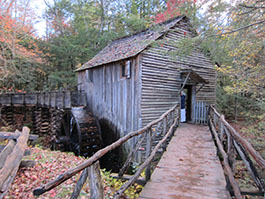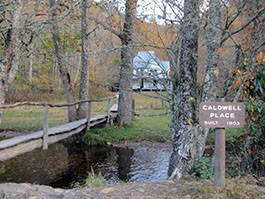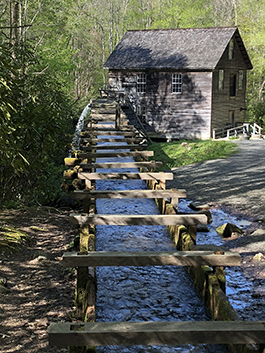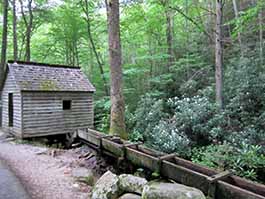
Historic Structures
Great Smoky Mountains National Park has one of the best collections of log structures in the eastern US. Almost 80 historic structures have been preserved or rehabilitated in the park, including houses, barns, outbuildings, churches, schools, and grist mills. Most of these structures are in Cades Cove, Cataloochee, Oconaluftee, and on the Roaring Fork Motor Nature Trail.
| Cades Cove | ||
 |
By 1850 the population in Cades Cove had peaked to 685. With the soil growing tired, and new states opening in the West, many families moved out in search of more fertile frontiers. By 1860 only 269 people remained. Slowly, human numbers rose again to about 500 just before the Park was established in the late 1920s. A number of historic buildings remain, including houses, barns, outbuildings, churches, and grist mills. Cades Cove historic buildings |
|
Directions: From Townsend, TN, turn right on Little River Road. From Sugarlands Visitor Center outside of Gatlinburg, TN, turn right onto Little River Road. Continue straight when arriving in Townsend, TN. |
||
| Cataloochee | ||
 |
Surrounded by 6,000-foot peaks, Cataloochee Valley is isolated yet it was the largest and most prosperous settlement in what is now Great Smoky Mountains National Park. Once known for its farms and orchards, today's Cataloochee is one of the most picturesque areas of the park. When visiting Cataloochee, you will also see a herd of elk grazing in the fields.
Cataloochee historic buildings |
|
Directions: From I-40, exit at North Carolina exit #20. After 0.2 mile, turn right and follow the signs 11 miles into Cataloochee Valley. To get there from Oconaluftee or Cherokee, take the Blue Ridge Parkway to Highway 19. Follow 19 (toward Asheville) through Maggie Valley. Turn left onto Highway 276 N. Just before the entrance ramp to I-40 (but past gas station), turn left and follow the signs 11 more miles to Cataloochee. |
||
| Grist Mills | ||
 |
Grist mills played a vital role in the lives of people who lived in the national park prior to the late 1920s. The most important crops grown on farms in the Great Smoky Mountains were those that provided bread. Rye, barley, and oats were grown in small amounts. Wheat was important, but the main crop that filled farmers' fields was corn. Cornmeal, prepared as cornbread, mush, hoe cakes, and spoon bread, made up the backbone of many a meal served in the Smokies. George Moore, a local resident who remembers riding on horseback to a Smokies mill when he was a boy, also recalls many a supper of nothing but corn bread and milk. Two grist mills are still operating, Mingus Mill and Cable Mill, and meal can be purchased at the mills. Grist Mills |
|
| Oconaluftee Mountain Farm Museum | ||
 |
The Mountain Farm Museum, situated on the banks of the Oconaluftee River just inside Great Smoky Mountains National Park, is a collection of of southern Appalachian farm buildings assembled from different locations throughout the Park. The farmstead has a crop in the field with the Smoky Mountains as a back drop. Live farm animals are raised during the summer. Visitors are welcome to visit the chestnut log farmhouse, barn, hen house, apple house, springhouse, and blacksmith shop. Often you will see many elk grazing in the field next to the museum.
Farm Museum |
|
Directions: Cherokee, NC take Hwy 441 (Newfound Gap Road). As you enter the national park you will see the farm on your right. From Gatlinburg, TN take Hwy 441 (Newfound Gap Road). Travel 13 miles to Newfound Gap then travel 19 miles where you will find the farm on your left. |
||
| Roaring Fork Motor Nature Trail & Cherokee Road | ||
 |
The Roaring Fork Motor Nature Trail is an intimate journey through the Smoky Mountain's lush mountain wilderness. In places, it reveals some of nature's secrets, while in others it weaves the story of the people who once lived here. Water is a constant companion on this journey. Cascades, rapids, and falls adorn the roadside. The sound of rushing water is never far away. The air feels damp and tropical throughout the summer months, yet the icy water rarely reaches 60o F. Along the way you will see several historic cabins and other structures. Roaring Fork Historic Buildings |
|
Directions: From downtown Gatlinburg, take Historic Nature Trail and follow that past the public park. You will be guided by signs after passing the park. |
||
Things to Do:
• 101 Things to Do in Great Smoky Mountains National Park
• Things to Do in the Smoky Mountains
• 25 Fun Things to Do in the Fall in the Smoky Mountains
• Scenic Roadways
• Hiking Trails
• Clingmans Dome
• Waterfalls
• Fishing
• Camping
| WELCOME TO GREAT SMOKY MOUNTAINS NATIONAL PARK Trip Ideas Great Smoky Mountains Facts Policies Institute at Tremont Order Your Free Visitor's Guide Transportation & Airports Local News Photo Tours • Fall Photo Tour • Roaring Fork Motor Nature Trail • Smoky Mountain Fall Foliage • Fall Foliage at Clingmans Dome • Fall Colors in nearby Villages • Fall in Wears Valley • Best Fall Hikes in the Smokies |
WHAT TO DO Attractions Biking Fishing Hiking Outdoor Adventure Scenic Drives and Rides Shopping Heritage, History, & Culture Nature Activities |
WHERE TO STAY Bed & Breakfast Cabins Camping Condos Hotels WHERE TO EAT |
4 SEASONS Winter Spring Summer Fall WEDDINGS Wedding Services Honeymoon Cabins |
Surrounding Towns: • Cherokee • Gatlinburg • Maggie Valley • Pigeon Forge • Townsend • Wears Valley CONTACT Contact Add Your Site Advertise
|
